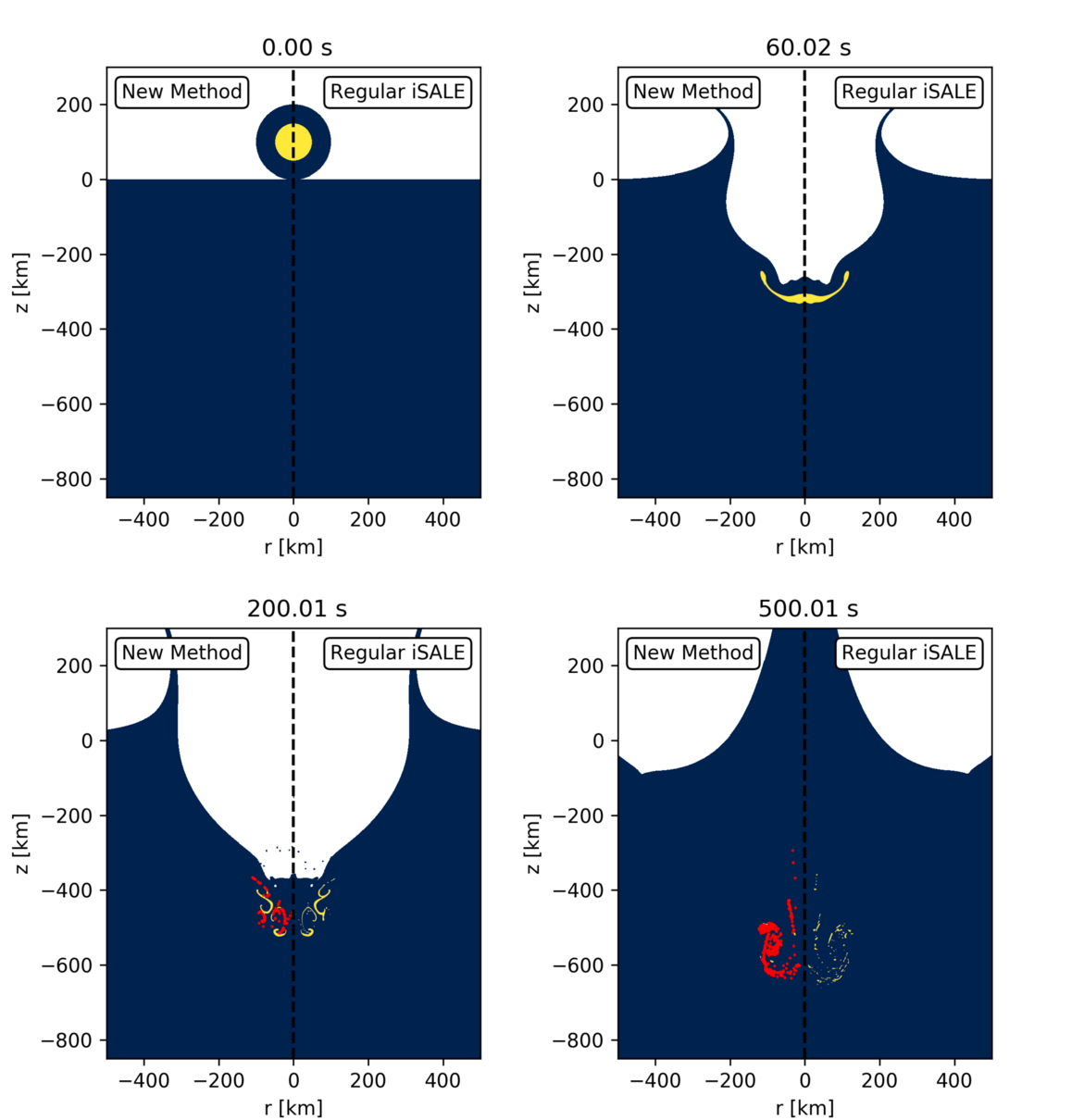- 1Museum für Naturkunde Berlin, Germany (randolph.roehlen@mfn.berlin)
- 2Freie Universität Berlin, Germany
- 3Universität Münster, Germany
Introduction: The late accretion phase is characterized by impacts of large differentiated bodies onto terrestrial planets. The material from these impacts could have changed Earth’s composition significantly. One noteworthy effect is that they may explain the high concentration of highly siderophile elements [HSE] in Earth’s contemporary mantle [1,2]. The likely presence of a deep magma ocean, as a consequence of giant collisions like the moon forming impact [3] necessitates a better understanding of impacts into such molten targets. To estimate the mixing of impactor material into the target body, it is essential to know both how much of the impactor stays in the mantle and how significantly it is fragmented due to the impact [4]. Different approaches have been used to analyze this problem in the past [4,5] and our work aims to expand on such studies. For this reason, we improved the treatment of fragmentation in the Eulerian shock physics code iSALE and used it to examine the effect of different impactor and target parameters on the fate of the impactor core.
Methods: We use the grid-based Eulerian shock physics code iSALE [6,7,8,9] to simulate impacts of differentiated bodies into a magma ocean. Such impact hydro codes are optimized to reproduce specific characteristics of the impact process, like the shock wave propagation or the crater formation. Small scale effects like fragmentation are in contrast insufficiently resolved and prone to artifacts. Our new method improves this and allows for a more accurate simulation of the fragmentation process down to the resolution limit of the simulation. It works by determining when fragments in the simulation reach a size close to the resolution limit and then using additional petrophysical criteria to represent fragmentation more accurately. The material of new fragments created by this method is then removed from the simulation grid and represented by particles instead.
The setup of our simulations consists of a differentiated body impacting into a magma ocean target. We vary several setup parameters, including the impact velocity and impactor size, as well as the depth of the magma ocean.
Results: Figure 1 shows the results of a simulation of an impact into a target with an infinite magma ocean depth at different time steps. It shows significant fragmentation of the impactor core in this case, both with and without the new method. The resulting fragment size frequency distributions are quite different though, with far finer fragmentation in the simulation with the new method.

Figure 1: Simulations with and without the new method at different time steps. The impactor core is shown in yellow and the particles in the new method in red.
The exact degree of impactor core fragmentation and weather the fragments end in the core or the magma ocean varies greatly based on the specific impact conditions. Generally speaking, impactor cores can punch through shallower magma oceans, even more at high impact velocities. However, such high velocities also cause more fragmentation of the impactor cores. For great magma ocean depths of more than two to three times the impactor radius, significant fragmentation is always observed and the resulting pieces remain almost completely in the magma ocean.
Acknowledgments: We gratefully acknowledge the developers of iSALE-2D, including Gareth Collins, Kai Wünnemann, Dirk Elbeshausen, Tom Davison, Boris Ivanov and Jay Melosh. We gratefully acknowledge the developers of iSALE-3D, including Dirk Elbeshausen, Kai Wünnemann, Gareth Collins and Tom Davison. This work was funded by the Deutsche Forschungsgemeinschaft (SFB-TRR170, subproject C2 and C4).
References: [1] Wood B. J. et al. (2006) Nature 441:825-833. [2] Walker R. J. (2009) Geochemistry 69:101-125. [3] Tonks W. B. et al. (1993) Journal of Geophysical Research: Planets 98:5319-5333. [4] Daguen R. et al. (2014) Earth and Planetary Science Letters 391:274-287. [5] Kendall J. D. et al. (2016) Earth and Planetary Science Letters 448:24-33. [6] Collins. G. S. et al. (2004) Meteoritics & Planetary Science 39:217-231. [7] Wünnemann K. et al. (2006) Icarus 180:514-527. [8] Elbeshausen, D. et al. (2009). Icarus, 204(2), 716-731. [9] Elbeshausen et al. (2011). Proceedings of 11th Hypervelocity Impact Symposium (HVIS), Fraunhofer Verlag.
How to cite: Röhlen, R., Wünnemann, K., Allibert, L., Maas, C., and Hansen, U.: Breaking or Entering? The Fate of Asteroid Cores During Impact Into a Magma Ocean., Europlanet Science Congress 2024, Berlin, Germany, 8–13 Sep 2024, EPSC2024-816, https://doi.org/10.5194/epsc2024-816, 2024.